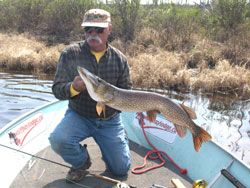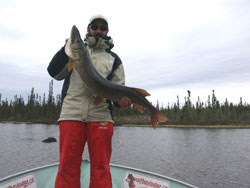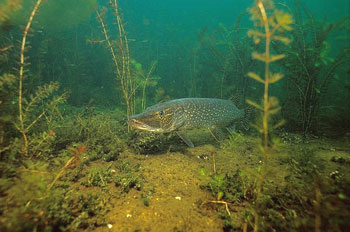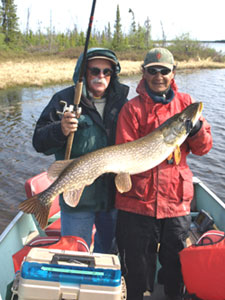 Across the range of northern pike, I have made, and watched others make, errors which caused either no or few pike or the loss of a trophy. From roughly 60-years of pike fishing, here’s a perspective on “seven deadly sins.”
Across the range of northern pike, I have made, and watched others make, errors which caused either no or few pike or the loss of a trophy. From roughly 60-years of pike fishing, here’s a perspective on “seven deadly sins.”
First, not “matching the hatch.” Trout anglers, including me, sometimes carry “matching the hatch” to extremes. Charles M. Meck’s recent The Hatches Made Simple: A Universal Guide to Selecting the Proper Fly at the Right Time suggests carrying 70 different patterns, not including variations in size, as the number required to meet most hatches. Including backups, that’s a lot of flies. Pike anglers need not go to such extremes, though it sure is fun to hear of a new lure or a dynamite color and run right off to buy it. And my “pike box” surely carries more than required.
While it may not be necessary to have all the possibilities with a duplicate in case one gets lost, successful pike anglers do “match the hatch.” Among the prime considerations pike anglers must take into account is “what is the predominant pike forage?” If fishing a familiar lake or river, the answer may already be known. Lures should match, roughly, the color and size of the predominant forage. In an unfamiliar setting, suckers and perch are prime forage for pike and lures matching those colors, 7- to 10-inches long, would be good places to start. Every body of water I ever fished had some forage species with light colored sides and a dark back – black, brown, blue, green. When in doubt, those are good colors to try. In lake trout waters, a rainbow trout colored Long A has resulted in a number of trophies for me. Of course, I never saw anything in the water that looks remotely like a red-and-white spoon. Yet I’ve caught many monster pike on them.
Second, not adapting to the signals pike provide. Earlier I did an article for thenextbite.tv recounting adaptations Mark Montesbroten and I made fishing Phelps Lake out of Wolf Bay Lodge in Saskatchewan. Weather turned bad. We were not catching the trophy pike we both knew were there. We tried different approaches until we found those that would work. In this case, we fished slower, with smaller lures than we might otherwise have used, and with darker lures. If you are not catching fish, the fish are trying to tell you something. Listen to them. Bill Tilden, a tennis great from the 1920’s, used to say (this is close and may not be exact), “If you’re losing, do something else. If you’re winning, keep doing what you are doing.” Such wisdom applies to pike fishing as well, particularly if success is rare. On a bad day, consider in detail exactly how you are fishing. Then do something else.

Third, not fishing the windy bank. Obviously, safety is paramount. Don’t risk life or equipment to fish the windy bank. Otherwise, fish the windy shoreline. Last spring Craig, my son, and I were fishing Phelps Lake with guide Glen Beatty. We rounded a point where the wind was blowing across the point. Craig brought a trophy to the side of the boat though it finally shook free because I was trying to get pictures. In the next hundred yards, we caught 4 pike over 40-inches.
Why the windy bank? Waves banging against the shore dislodge all sorts of tiny critters. Next in the food chain are crayfish and minnows which become more active feeding on the tiny critters. While the crayfish and minnows are taking advantage of the wind-induced disruption of the disrupted critters, the pike in turn take advantage of the wind-induced distraction of the foraging predators. Dozens of times I have returned to camp or the lodge or wherever I was staying to report pike fishing success when my companions reported failure. Warren Johnson and I did a comparable stunt a number of years ago fishing for walleyes in northern Ontario. Our buddies told us, “It was too windy there. We had to keep adjusting the boat. And it was hard to cast. We fished in the lee of the islands” (or in the back of some cove or – but you get the point). We caught 75 in a day when the others caught 10.
Fourth, not accommodating to the life cycle of pike. Pike move with the seasons. Perhaps the movement of pike in a body of water is not as dramatic as the migration of barren ground caribou, but particularly trophy pike modify their location throughout the year.
In very early spring, trophy pike are in shallow, dark-bottomed bays. Monsters can be caught on flies and topwater lures.  Gradually, pike move toward creek mouths to feed on spawning suckers (see my article in thenextbite.tv archive of articles). As the water warms, the largest pike move deeper and deeper, first at the outer edge of weed beds, then into the lake basin. As winter nears, the largest pike hover off rocky shoals and points to forage on spawning tullibees. Two keys trigger these movements: water temperature and availability of forage. Pike anglers dependent on “they were here a couple of weeks ago,” or “one of my buddies told me this was a hot spot when he fished this lake” are missing a bet. Fishing the wrong place at the wrong time.
Gradually, pike move toward creek mouths to feed on spawning suckers (see my article in thenextbite.tv archive of articles). As the water warms, the largest pike move deeper and deeper, first at the outer edge of weed beds, then into the lake basin. As winter nears, the largest pike hover off rocky shoals and points to forage on spawning tullibees. Two keys trigger these movements: water temperature and availability of forage. Pike anglers dependent on “they were here a couple of weeks ago,” or “one of my buddies told me this was a hot spot when he fished this lake” are missing a bet. Fishing the wrong place at the wrong time.
Fifth, not using balanced tackle. Fly rod anglers constantly talk about “balanced tackle,” with the strength and flexibility of the rod adjusted to the weight of the line. Pike anglers need to do the same. Heavy lures require heavy rods and line. Many who fly to remote lakes or drive to the end of the road arrive with tackle suited for 2- to 5-pound bass. They did not want to spend the additional amount for new gear. As a consequence, they either do not throw heavy pike-sized lures or they become exhausted in doing so. Throw a Suick Sucker or a Squirrely Burt all day on a rod designed for 3/8’s ounce lures; see how you feel. In the last decade, plus or minus, it has become easy to assemble balanced tackle for pike. Longer rods with more backbone and greater flexibility are common. No need to fish with a 5-foot pool cue. Braided line has become easier to cast and smaller diameter. Large arbor reels can accommodate heavier line. A large arbor reel both permits longer casts and more rapid retrieves as more line goes out or comes in with each revolution of the spool. In terms of quality, such gear has gotten cheaper over the last few years.
It may be that you only make a week-long trip to a trophy pike lake a year. Perhaps even only once a lifetime. Would be a shame to spend the money on the trip and not have the gear to make it a success.

Sixth, not fishing the surface. When I was a kid, fishing for pike in northern Michigan, one of the standard rules was “fish for bass on the surface and pike under the surface.” Took a while, but by the time I graduated from high school I had figured out both sides of the equation were bogus. My “eureka moment” for pike came late one afternoon on a small lake near our cabin. I was fishing a Bass Oreno, cranking it to dive a foot or so. Backlash. As the wooden lure lay on the surface, something grabbed it – to my complete amazement. For the rest of the day, I cast the plug toward the weed edge. Let it rest still on the water and gave it a twitch now-and-then. The lesson has served me well over the years.
Among my favorite topwater lures for pike is Mann’s largest 1-Minus. When I first met Mark Montesbroten, nearly a decade ago, he said, “We’ve been catching big pike on a lure I bet you don’t have. A 1-Minus.” I opened my box to show Mark half a dozen. When pike are in water less than 5-feet deep or lingering near the surface of subsurface weeds, a 1-Minus wobbled slowly only a few inches deep often results in monster strikes. Walk-the-dog style lures, like the largest Zara Spook, are also dynamite surface presentations for pike. Large bass buzzbaits are additional surface pike lures. For fly rod anglers seeking pike a Dahlberg Diver, deer-hair mouse or a Peck’s Popper are good choices.
Seventh, not being ready for the fish of a lifetime. Any cast or any trolling pass might result in the fish you have always wanted to catch. And “the big fish always gets away.” When I was 10-years old I saw my first trophy pike. Dad and I were trolling near Marquette, Michigan. Suddenly, Dad had one, a big one. People on the bank were yelling advice. Finally Dad got the big fish – well over 40-inches I’m sure – close to the boat. No net. As the fish lay exhausted, the lure dropped off the monster pike and the fish slowly moved away. Sixty years later I can still visualize it. Folks often ask, when they see the net I carry, “My gosh, how big a fish do you plan to catch?” I answer, “Biggest one in the lake.” Several times I’ve tried to land a pike or musky too large to accommodate the net I had. No more. Adequate landing gear is only one “readiness” issue. Nicks in line or leader, weakened knots, compromised terminal tackle are other careless practices which cause the loss of trophy pike. A number of years ago I interviewed guides across North America asking “why big fish get away.”
Whether their quarry was musky, pike, walleyes, bass or trout, the common theme of their answers was “angler error.” And not being ready was a common element of those errors.
So, for advice: go and sin no more.










